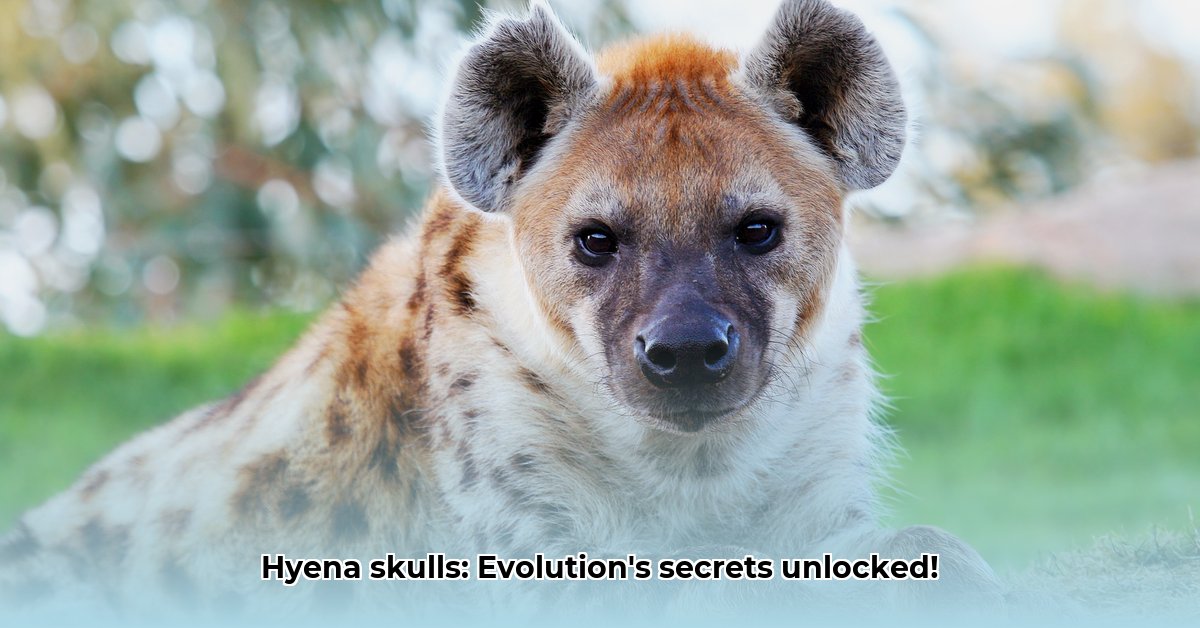Ever wondered what makes a hyena skull so unique? These fascinating animals have skulls perfectly designed for their diverse lifestyles, from crushing bones to gobbling down insects. We’ll explore different hyena skulls, comparing jaws, teeth, and key features to see how they intricately relate to diet and lifestyle. We’ll uncover how evolution has shaped these remarkable skulls, showcasing how different hyena species have developed specialized features independently, and how their skulls tell captivating stories of their place in the animal kingdom. Get ready to discover the secrets hidden within the hyena’s head!
Hyena Skull: Unlocking Nature’s Engineering Marvels
Hyena skulls – they’re not all the same! These meticulously crafted bones are far more interesting than you might initially think, holding valuable clues to millions of years of evolution and adaptation. Consider, for instance, the stark contrast between a spotted hyena’s robust, bone-crushing skull and an aardwolf’s slender, delicate one. We’ll explore such fascinating variations as we delve into the hidden secrets within these remarkable animal craniums. It’s like a biological detective story, except the intriguing clues are bony ridges, specialized teeth, and uniquely shaped jaw structures! What precise role does natural selection play in shaping the diverse and specialized skull structures observed across different species of hyenas?
The Hyena Skull’s Amazing Variety: A Detailed Look
Hyena skulls exhibit an incredible range of sizes and shapes, each uniquely reflecting its species’ specific diet and lifestyle–a compelling example of how animals adapt for survival. One particularly telling feature is the sagittal crest, a prominent bony ridge running along the top of the skull. In spotted hyenas, this crest is exceptionally huge and well-developed! It functions as a powerful lever, granting their incredibly strong jaw muscles the mechanical advantage needed to generate immense force for crushing even the largest bones. Other hyenas, such as the aardwolf, possess significantly smaller crests, reflecting their reduced need for such bone-crushing power. Their diet consists primarily of termites and other insects, a food source requiring far less forceful jaws. How precisely does the size and prominence of the sagittal crest correlate with the specific dietary habits and feeding behaviors of different hyena species?
Their teeth are equally telling, providing further insights into their dietary preferences. Spotted hyenas are equipped with formidable premolars and molars, specifically formed and adapted for cracking and crunching bones with ease. Aardwolves, conversely, have smaller, reduced teeth, which are far better suited for efficiently processing their insect-based diet. The jaw structure itself also varies considerably between different species. Hyena species that specialize in bone-crushing tend to have jaws that are robustly built for exceptional strength and resilience. Hyenas with comparatively lighter jaws likely target softer prey that demands considerably less biting force.
Here’s a detailed summary highlighting the key differences in skull morphology across the four hyena species:
| Hyena Species | Sagittal Crest Description | Dentition Description | Jaw Strength | Main Dietary Habits |
|---|---|---|---|---|
| Spotted Hyena | Extremely Prominent, Robust | Powerful, specialized for bone-crushing and shearing meat | Very Strong | Primarily bone-crushing carnivore and scavenger |
| Striped Hyena | Moderately Prominent | Strong, adapted for varied prey, opportunistic feeding | Strong | Carnivore, scavenger, and omnivore |
| Brown Hyena | Moderately Prominent | Strong, capable of handling various prey, generalist diet | Strong | Scavenger and opportunistic carnivore, fruits, insects |
| Aardwolf | Very Small or Almost Absent | Reduced, peg-like, specialized for insects | Relatively Weak | Primarily insectivorous (termites) |
Does the presence of these specific dental adaptations in different hyena species directly influence their feeding behavior, prey selection strategies, and overall ecological roles within their respective habitats?
Evolutionary Journeys: Shared Traits and Unique Paths
The evolution of the diverse hyena skull is a compelling story of both convergent and divergent evolution, showcasing nature’s ingenuity. Convergent evolution occurs when unrelated species independently develop similar traits due to facing similar environmental pressures or occupying comparable ecological niches. We see a striking example of this principle in the powerful jaws exhibited by some hyenas and certain canids (such as wolves). These distantly related species independently evolved similar jaw structures because a powerful bite conferred significant survival advantages in their respective predatory or scavenging lifestyles. However, hyena skulls also retain unique features that distinctly set them apart from canids, reflecting their own separate evolutionary history and distinct genetic lineage. It’s a testament to nature’s boundless creativity, revealing how different species can arrive at similar solutions to comparable challenges while still maintaining their own unique identities. Which specific evolutionary processes have driven the remarkable diversification of skull morphologies within the hyena family, and how do these processes relate to the ecological niches occupied by each species?
Diet and Lifestyle: The Clues Within the Skull
The shape, size, and specialized features of a hyena skull are directly and intimately related to the animal’s specific diet and overall lifestyle. The spotted hyena’s skull exemplifies biological engineering, a testament to its bone-crushing prowess and scavenging lifestyle. In stark contrast, the aardwolf’s delicate skull reflects its specialized, insect-based diet. Each adaptation is a profound story of evolutionary success, highlighting the power of natural selection in shaping the incredible diversity of life on Earth. How does the fundamental principle of natural selection explain the observed correlation between diet, skull morphology, and behavioral adaptations in hyenas?
The Ongoing Puzzle of Hyena Skulls: Future Research
Our scientific understanding of hyena skulls is continuously evolving and expanding! Ongoing research utilizes cutting-edge tools and advanced techniques to explore the intricate connections between genetics, skull structure, and hyena behavior in unprecedented detail. As scientists continue to delve deeper into these fascinating details, we can anticipate even more groundbreaking insights into these remarkable animals. The hyena skull remains a remarkably rich source of invaluable information, offering a unique window into millions of years of adaptation and survival in diverse African ecosystems. By meticulously studying these bones, we can piece together the compelling story of one of nature’s most intriguing families. There’s still much to learn and uncover–future discoveries promise to reveal even more hidden aspects of hyena evolution and biology. What specific advancements in technology and research methodologies are expected to significantly enhance our understanding of hyena skull evolution in the coming years, and what pivotal questions might these advancements help to answer?
How do hyena skull morphology variations relate to geographic location and dietary specialization?
Key Takeaways:
- Spotted hyena skull size shows a stronger link to population density than to climate, supporting the Energetic Equivalence Rule.
- Smaller skulls are found in high-density areas, likely due to resource competition.
- Females consistently exhibit slightly larger skulls than males. But this difference isn’t strongly linked to geography.
- Bergmann’s Rule, predicting larger size in colder climates, has limited support in this context.
Skull Size and the Energetic Equivalence Rule
Let’s delve deeper into the fascinating world of spotted hyena skull variations. Why are some skulls significantly larger than others, and what intriguing insights can these size differences provide? Skull size isn’t random. Research points to a notably stronger correlation with population density than with climate. This is strikingly consistent with the Energetic Equivalence Rule (EER). Imagine a buffet scenario: When food resources are plentiful and competition is low (low population density), individuals can afford to develop and maintain larger bodies. But in a crowded buffet setting (high population density), smaller individuals are more efficient at acquiring resources, allowing a greater number of individuals to share the limited food. Smaller skulls often reflect this adaptation to resource scarcity in high-density populations found in specific regions of sub-Saharan Africa. What other critical ecological factors, beyond population density, could potentially influence the skull size variations observed in spotted hyenas across different geographic regions?
Geographic Distribution and Skull Dimensions
The geographic location where a hyena lives and thrives can significantly impact its skull size and overall morphology. The largest skulls tend to be found in areas with lower hyena densities and more abundant resources. Conversely, smaller skulls are frequently concentrated in areas with high-density populations, where competition for resources is more intense. This isn’t solely attributable to temperature or rainfall, though those factors undoubtedly play a crucial role in shaping overall habitat suitability and food abundance. The geographical distribution of skull morphology suggests a primary influence from environmental pressures directly related to resource availability. In what specific regions of sub-Saharan Africa are the most pronounced variations in spotted hyena skull size observed, and what key environmental factors characterize these diverse areas?
Sexual Dimorphism in Skull Size
Interestingly, female spotted hyenas consistently exhibit slightly larger skulls than their male counterparts. This subtle yet consistent difference appears to be largely independent of geographic location, suggesting its roots in intrinsic social dynamics and reproductive strategies within hyena clans. These larger skulls in females might reflect the inherent challenges faced by dominant females in securing adequate food resources for themselves and their dependent young. It’s a compelling example of the intricate interplay between social hierarchy and physical characteristics in shaping the lives of these fascinating animals. What specific social behaviors and reproductive strategies exhibited by female spotted hyenas might contribute to their larger skull size compared to males within the same geographic regions?
Bergmann’s Rule: A Limited Role
The well-established Bergmann’s Rule – which postulates that animals tend to be larger in colder climates – doesn’t appear to strongly influence spotted hyenas’ skull size. Temperature fluctuations across their geographic range do not explain the observed skull size variations as effectively as population density and resource
- Post 1 - October 24, 2025
- Find Great Games Similar to Repo: Best Co-op Horror Now - September 29, 2025
- Top 10 Games Like Repo: 2025’s Best Co-op Horror - September 26, 2025









